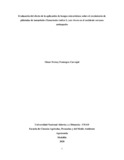Please use this identifier to cite or link to this item:
https://repository.unad.edu.co/handle/10596/33357Full metadata record
| DC Field | Value | Language |
|---|---|---|
| dc.contributor.advisor | Muñoz Monsalve, Catalina | - |
| dc.coverage.spatial | cead_-_medellín | spa |
| dc.creator | Fonnegra Carvajal, Omar Ferney | - |
| dc.date.accessioned | 2020-04-17T21:25:08Z | - |
| dc.date.available | 2020-04-17T21:25:08Z | - |
| dc.date.created | 2020-04-16 | - |
| dc.identifier.uri | https://repository.unad.edu.co/handle/10596/33357 | - |
| dc.description.abstract | Los hongos formadores de micorrizas arbusculares (HFMA) son aquellos que forman simbiosis mutualistas con las raíces de la mayoría de las especies vegetales. El efecto positivo más significativo es el mejoramiento de estado nutricional de las plantas, ya que las hifas de estos hongos se extienden en el suelo y pueden absorber y transferir nutrientes hacia las raíces. En ese sentido, la mayor captación de nutrientes, particularmente los poco móviles como el P, se logra ampliando el volumen de suelo explorado y alcanzando zonas donde los nutrientes se encuentran disponibles. El tamarindo es una especie vegetal de gran importancia en los municipios del occidente cercano antioqueño. De este frutal muchas familias de la zona obtienen ingresos con la transformación de la pulpa de estos frutos. Estos árboles se encuentran dispersos, y en algunos casos en arreglos silvopastoriles. A pesar de su impacto cultural y económico en estas comunidades rurales, el tamarindo no recibe un buen manejo y acompañamiento agronómico, por lo que la producción no está bien orientada y no se logra aun el potencial del cultivo. El objetivo de este trabajo fue evaluar el efecto de la aplicación de hongos micorrízicos sobre el crecimiento de plántulas de tamarindo (Tamarindus indica L.) en vivero en el occidente cercano antioqueño. Los ensayos en la etapa de vivero se realizaron en la Granja John Jairo González del Politécnico Colombiano Jaime Isaza Cadavid, en el municipio de San Jerónimo Antioquia. Se realizó un diseño completamente al azar con tres (3) tipos de inóculo micorrizal (Glomus, Acaulospora, Micorriza Comercial ((mezcla con los géneros Glomus, Acaulospora, Scutellospora y Entrophospora)) y el control (Sin Micorriza), dos (2) niveles de fosforo de 0,03 mg/L y 0,2 mg/L, con diez (10) repeticiones para un total de ochenta (80) plantas de tamarindo. Se evaluaron las variables de crecimiento y desarrollo: número de hojas, altura de la planta y diámetro de tallo durante 21 semanas. En conclusión, la aplicación de micorrizas en la etapa de vivero en la producción de plántulas de tamarindo tiene un efecto positivo sobre la variable número de hojas y esto a su vez, sobre el crecimiento y desarrollo. Este resultado, es de gran utilidad y se plantea como una alternativa para el manejo agronómico del tamarindo en la zona. | spa |
| dc.format | ||
| dc.title | Evaluación del efecto de la aplicación de hongos micorrízicos sobre el crecimiento de plántulas de tamarindo (Tamarindus indica L.) en vivero en el occidente cercano antioqueño, | |
| dc.type | Proyecto aplicado | |
| dc.subject.keywords | Planta, hongo, Suelo, Producción, Nutrición de las plantas, Vivero. | spa |
| dc.description.abstractenglish | Arbuscular mycorrhizal fungi (HFMA) are those that form mutual symbiosis with the roots of most plant species. The most significant positive effect is the improvement of the nutritional status of the plants, since the hyphae of these fungi spread in the soil and can absorb and control nutrients towards the roots. In this sense, the greatest uptake of nutrients, especially those that are not very mobile, such as P, is achieved by expanding the volume of soil explored and reaching areas where nutrients are available. Tamarind is a plant species of great importance in the municipalities of western Antioquia. From this fruit tree many families in the area earn income by transforming the pulp of these fruits. These trees are scattered, and in some cases in silvopastoral arrangements. Despite its cultural and economic impact on these rural communities, tamarind does not receive good agronomic management and support, so production is not well oriented and the potential of the crop is not yet achieved. The objective of this work was to evaluate the effect of the application of mycorrhizal fungi on the growth of seedlings of tamarind (Tamarindus indica L.) in a nursery in the near west of Antioquia. The tests in the nursery stage were carried out at the John Jairo González Farm of the Colombian Polytechnic Jaime Isaza Cadavid, in the municipality of San Jerónimo Antioquia. A completely randomized design was made with three (3) types of mycorrhizal inoculum (Glomus, Acaulospora, Commercial Mycorrhiza ((mixes with the Glomus, Acaulospora, Scutellospora and Entrophospora genera)) and the control (Without Mycorrhiza), two (2) Phosphorus levels of 0.03 mg / L and 0.2 mg / L, with ten (10) repetitions for a total of eighty (80) tamarind plants.The growth and development variables were evaluated: number of leaves, height of the plant and stem diameter for 21 weeks. In conclusion, the application of mycorrhizae in the nursery stage in the production of tamarind seedlings has a positive effect on the variable number of leaves and this, in turn, on growth and development. This result is very useful and is proposed as an alternative for the agronomic management of tamarind in the area. | spa |
| dc.subject.category | Agronomía | spa |
| Appears in Collections: | Agronomía | |
Files in This Item:
| File | Description | Size | Format | |
|---|---|---|---|---|
| offonnegrac.pdf | 2.12 MB | Adobe PDF |  View/Open |
Items in DSpace are protected by copyright, with all rights reserved, unless otherwise indicated.
